Back in the 1950s and 1960s, if you were a photographer, you probably heard of a small Japanese company called the Miranda Camera Corporation. Even if you didn’t own a Miranda camera, you probably remember their ads.
Miranda originally started in 1946 as Orion Seiki Sangyō Y.K., (in English, Orion Precision Products Industries Co., Ltd.) as a maker of miscellaneous photography related accessories. The company’s first camera was called the Orion Phoenix, but the name “Phoenix” was already trademarked by someone, so at the last second, the name was changed to the Orion Miranda.
The first Miranda camera was quite an ambitious model with features that put it in direct competition with other professional grade cameras like the Ihagee Exakta and KW Praktina. It offered features like an interchangeable viewfinder and a dual lens mount which allowed it to be very competitive in the marketplace. The original Miranda was a mild success in Japan, and in an effort to distance itself from it’s earlier products, Orion would change it’s name in 1957 to the Miranda Camera Company.
Miranda has an interesting history that I explore more in my review for the Miranda D from 1960. Despite being a Japanese company, Miranda cameras would be exclusively exported to the west, sold primarily in the United States by an US importer called Allied Impex Corporation, or AiC for short.
AiC had offices in New York, Chicago, Los Angeles, and Dallas, and had been searching for a way for it’s products to stand out from the massive number of competing cameras being made in Japan and Germany at the time. At some time in the late 1950s (the image above of the woman laying in the hammock features the Miranda A which was released in 1958), AiC had hired a New York ad agency run by Nat Kameny to create a series of advertisements for it’s cameras.

I don’t know a ton of the backstory of how and why Miranda decided to go in the direction they did, but whatever the reason why, they decided to hire photographer Hal Reiff to shoot barely dressed women posing in front of an overdressed man acting out various fictional photo shoots. I picture this playing out in my head as an episode of the show Mad Men, where Don Draper calls in a photographer to shoot some dames in compromising positions while sucking down a pack of Lucky Strikes.
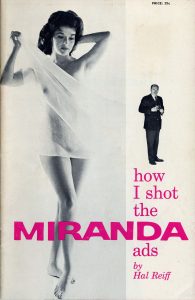 In late 2017, I stumbled upon this little 18 page pamphlet in an antique shop in Crown Point, Indiana called “How I shot the MIRANDA Ads, by Hal Reiff”. The pamphlet was very old, but in very good condition. The cover had a mark indicating that it once sold for 25 cents. The pamphlet was not dated, but the last few pages serve as an advertisement for the Miranda D and the Automex, both which debuted in 1960, so it likely was printed around that time.
In late 2017, I stumbled upon this little 18 page pamphlet in an antique shop in Crown Point, Indiana called “How I shot the MIRANDA Ads, by Hal Reiff”. The pamphlet was very old, but in very good condition. The cover had a mark indicating that it once sold for 25 cents. The pamphlet was not dated, but the last few pages serve as an advertisement for the Miranda D and the Automex, both which debuted in 1960, so it likely was printed around that time.
I scanned in the pages of the entire pamphlet here for you to read, so I won’t repeat too much of what’s in there, but it’s a really fascinating look back on a time when exploiting scantily clad women in advertisements was not considered taboo. Sure, nudity was not on the front page of the Sunday Times either, but to exploit a woman in a provocative position to sell a camera didn’t seem to bother anyone.
Miranda released a ton of ads, many of them featuring the same dark haired woman and overdressed male which the pamphlet identify only as Nancy and Bill. Although in most of the ads, other objects like lenses or other props block Nancy’s naughty parts, there’s enough there to where you don’t need much imagination for anything else.
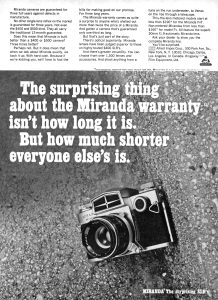
Even when Miranda made an ad that didn’t feature any people, they often laid on thick sexual innuendo that was almost as provocative as the images themselves, like the ad to the left that ensures that says everyone else’s warranty is so short compared to the long one you are graced with when buying a Miranda.
The pamphlet breaks down a few of Reiff’s photo shoots and shows exactly how he set them up and what equipment he used. He admits to using unidentified TLRs and 8×10 studio cameras, but I was impressed that a good number of the ads were shot using real Miranda cameras. I’ve often wondered how many Nikon, Camera, or Minolta camera ads were shot with the same cameras that were being advertised.
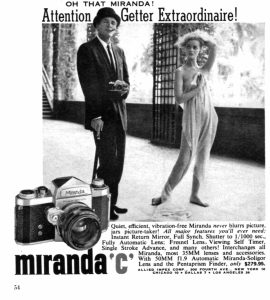
Throughout the pamphlet, Reiff shares other quick anecdotes about shooting on location in cold water, how he created the “hanging swing” shot, causing a ruckus at a Puerto Rican horse racing track, and how on occasion, he was forced to use models other than Nancy and Bill and how he felt those images ruin the feel of the series.
The pamphlet ends with two pages that advertise the Miranda Automex, Miranda D, and the various accessories available, suggesting the initial purpose of this was as an advertisement.
Overall, I found the entire thing to be a really interesting look back at how things used to be done. This is even more relevant today with the #metoo discussions surrounding the victimization of women in various industries. I wonder what “Nancy” would have to say about this if she were still alive?
I appreciated the technical explanations of the photo shoots, some of the stories, and of course, the pretty ladies, but at the end I’m left wanting more. Who were Nancy and Bill? What were their last names? Did they do anything else in their careers? Why did Miranda choose to go with this type of advertisement in the first place? For anyone who has read some of my camera reviews, you know that I appreciate the history and backstories almost as much as the cameras themselves, and I want to know more.
This little 18 page glimpse to the past is likely all I’ll get, and that’s OK. I thought I would share with you my little find and hopefully you’ll find it as interesting as I have.
Edit 3/28/2021: Recently, a reader named Maureen contacted me to let me know that her aunt is Nancy from the Miranda ads. She said that Nancy is 89 years old and still alive today, living in New Jersey. A member of her family shared this article with her and she got a kick out of reading about her days of shooting these ads. I had asked if she would be willing to do a short interview to talk about those days but Nancy respectfully declined, saying that those were fun times, but that she wants to remain private, which I absolutely respect. Still, it’s cool to hear an update like this and thought I’d share.
Click on each thumbnail below to get a high resolution image that should be easy to read on a computer screen.
Finally, here are a few more ads that I found while researching this article for you to…research!
Credit: Most of these Miranda ad scans came from the Flickr page of ‘shotput888’.

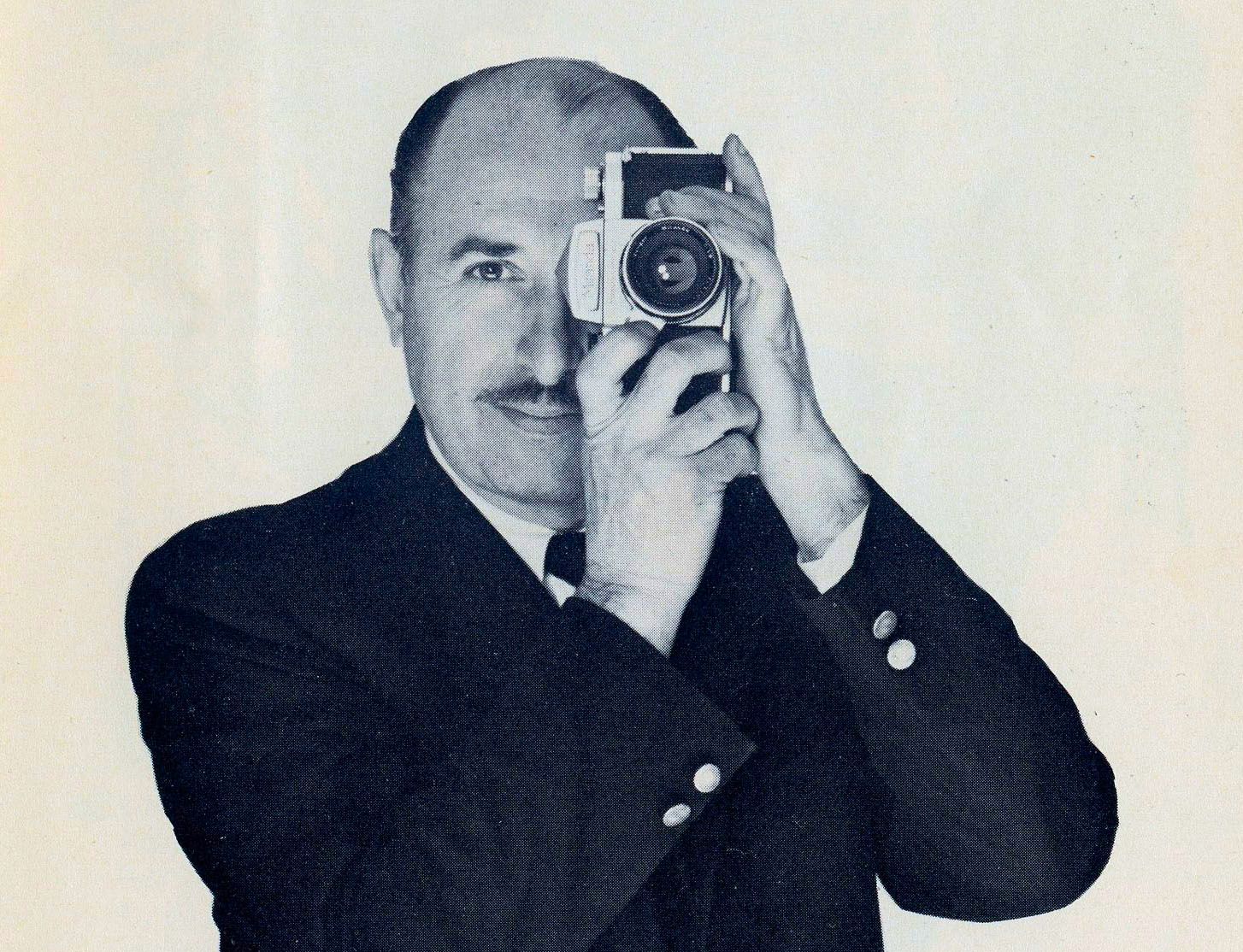





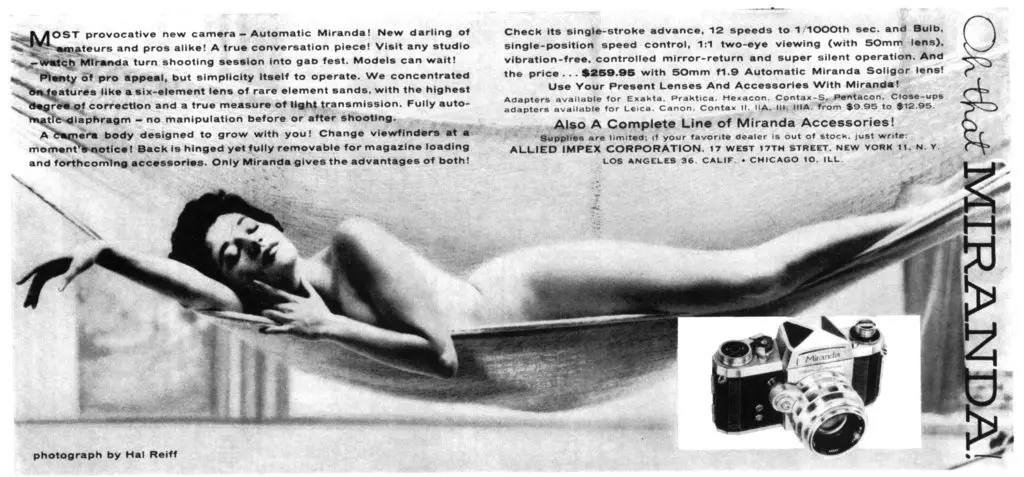


















Interesting post. Advertising of that time period was taking bold steps, and New York advertisers led a good many edgey campaigns for companies looking to stand out. Choosing Hal Reiff’s shop almost guaranteed the female exploitive look because that seemed to be his signature style. A little Googling on him shows a wealth of other ads and even paintings done by him over several decades with models. Informative to see that maybe his photographic style influenced his painting or vice versa. One doesn’t see too much of that in photographers where they were capable in both.
I’m looking for a Miranda TODAY! 😉
What a fantastic glimpse into the past! Thanks a lot for uploading this, Mike – it leads me to wonder just how Miranda cameras weren’t sold in higher numbers back then… but then I remember places like DPR, and the curmudgeons that populate the forums, and it all makes sense. Nude women can help sell cars, tobacco and booze, but not cameras or computers; these and other technical devices are the domain of gearheads
One of the ads that sold me on Miranda’s Sensorex model was the one that ran in the early 70”s (in color) talking about taking it to a south seas island to photography tribes-people. I remember it vividly! Had a picture of the Sensorex in both silver finish and black finish in the corner, and had a lot of copy about being stuck on an island and needing dependability!
If you can’t be creative or original just throw a half naked woman on the product. Sad.